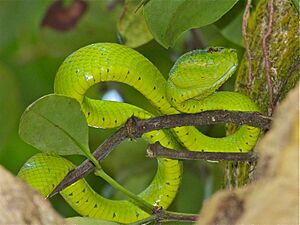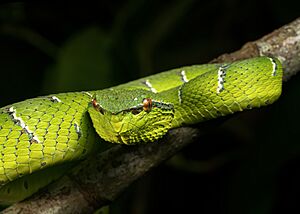Tropidolaemus subannulatus facts for kids
Quick facts for kids Tropidolaemus subannulatus |
|
|---|---|
 |
|
| Conservation status | |
| Scientific classification | |
| Genus: |
Tropidolaemus
|
| Species: |
subannulatus
|
The Bornean keeled green pit viper is a fascinating snake found in parts of Southeast Asia. It is also known as the North Philippine temple pit viper. This snake lives in countries like Brunei, Indonesia, Malaysia, and the Philippines. It is a type of venomous snake called a pit viper. Until 2007, scientists thought this snake was part of a larger group called the Tropidolaemus wagleri species.
Contents
What Does It Look Like?
The Bornean keeled green pit viper is usually a bright green color. It often has many thin bands across its body. These bands can be blue, red, or white. Some of these snakes might even have a light green or blue background color.
Female snakes of this species are much bigger than males. Females can grow up to 96 centimeters (about 3 feet) long. Males are smaller, reaching about 46 centimeters (about 1.5 feet). Young snakes and males usually have red dots on their bellies. Females might have blue or red dots.
Where Does It Live and What Does It Eat?
This snake is very common in the lowland rainforests of Borneo. It spends most of its life in trees and bushes. This is called being arboreal. It has a special tail that can grip branches, helping it move around. You can find these snakes in plants up to 20 meters (about 65 feet) high.
The snake's green color helps it blend in perfectly with the leaves. This is called camouflage. It helps the snake hide from animals that might want to eat it. It also helps the snake hide from its prey. This pit viper eats birds, small mammals, and frogs.
Reproduction and Life Cycle
The Bornean keeled green pit viper gives birth to live young. This is different from snakes that lay eggs. This type of birth is called ovoviparous. The mother snake carries the eggs inside her body until they hatch. Then, the baby snakes are born alive.
About Its Venom
Scientists are still learning about the venom of the Bornean keeled green pit viper. It is likely similar to the venom of Tropidolaemus wagleri. This is because they were once thought to be the same species.
The venom of T. wagleri mostly affects the nervous system. This is called neurotoxic venom. It also has a smaller amount of venom that affects blood. This is called hemotoxic venom.
Bites from T. wagleri are usually not deadly. The effects are often felt only where the bite happened. However, it is always important to be very careful around any venomous snake. Even if a snake's bite is not usually deadly, some people can have a serious allergic reaction called anaphylaxis. This can be dangerous.



